Enhanced Electrocatalytic Behaviour of Poy(aniline-co-2-hydroxyaniline) Coated Electrodes for Hydrogen Peroxide Electrooxidation
Abstract
:1. Introduction
2. Results and Discussion
2.1. Cyclic Voltammetry Analysis
2.1.1. Scan Rate and Rate Constant Analysis
2.1.2. Electrochemical Response with an Increase in Concentration
2.2. Square Wave Voltammetry Analysis
Electrochemical Response with an Increase in Concentration
2.3. Differential Pulse Voltammetry Analysis
Electrochemical Response with Increase in Concentration
2.4. Stability, Sensitivity, and Reproducibility
2.5. Electrochemical Impedance Measurements
3. Materials, Instruments, and Methods
3.1. Materials and Instrument
3.2. Electrode Preparation
4. Conclusions
Supplementary Materials
Author Contributions
Funding
Acknowledgments
Conflicts of Interest
References
- Cehoin, M.; Medic, A.; Scheideler, J.; Mielcke, J.; Ried, A.; Ompare, B.K.; Gotvajn, A.Z. Hydrodynamic cavitation in combination with the ozone, hydrogen peroxide and the UV-based advanced oxidation processes for the removal of natural organic matter from drinking water. Ultrason. Sonochem. 2017, 37, 394–404. [Google Scholar] [CrossRef]
- Lu, Z.; Chen, G.; Siahrostami, S.; Chen, Z.; Liu, K.; Xie, J.; Liao, L.; Wu, T.; Lin, D.; Liu, Y.; et al. High efficiency oxygen reduction to hydrogen peroxide catalyzed by oxidized carbon material. Nat. Catal. 2018, 1, 240–245. [Google Scholar] [CrossRef]
- Sun, Y.; Luo, M.; Meng, X.; Xiang, J.; Wang, L.; Ren, Q.; Guo, S. Graphene/intermetallic PtPb nanoplates composites for boosting electrochemical detection of H2O2 released from cells. Anal. Chem. 2017, 89, 3761–3767. [Google Scholar] [CrossRef] [PubMed]
- Ju, J.; Chen, W. In situ growth of surfactant-free gold nanoparticles on nitrogen-doped graphene quantum dots for electrochemical detection of hydrogen peroxide in biological environments. Anal. Chem. 2015, 87, 1903–1910. [Google Scholar] [CrossRef] [PubMed]
- Gaschler, M.M.; Stockwell, B.R. Lipid peroxidation in cell death. Biochem. Biophys. Res. Commun. 2017, 482, 419–425. [Google Scholar] [CrossRef] [PubMed]
- Rahimifard, M.; Nigjeh, M.N.; Baeeri, M.; Maqbool, F.; Abdollahi, M. Multiple protective mechanisms of alpha-lipoic acid in oxidation, apoptosis and inflammation against hydrogen peroxide induced toxicity in human lymphocytes. Mol. Cell. Biochem. 2015, 403, 179–186. [Google Scholar] [CrossRef] [PubMed]
- Zhang, H.; Li, S.; Zhang, F.; Wang, M.; Lin, X.; Li, H. Simultaneous detection of hydroquinone and catechol on electrochemical-activated glassy carbon electrode by simple anodic and cathodic polarization. J. Solid State Electrochem. 2017, 21, 735–745. [Google Scholar] [CrossRef]
- Yanga, X.; Kirscha, J.; Olsenb, E.V.; Fergus, J.W.; Simonian, A.L. Anti-fouling pedot: PSS modification on glassy carbon electrodes for continuous monitoring of tricresyl phosphate. Sens. Actuators B 2013, 177, 659–667. [Google Scholar] [CrossRef]
- Silva, L.V.; Lopes, C.B.; Silva, W.C.; Paiva, Y.G.; SantosSilva, F.A.; Lima, P.R.; Kubota, L.T.; Goulart, M.O.F. Elevtropolymerization of ferulic acid on multi-walled carbon nanotubes modified glassy carbon electrode as a versatile platform for NADH, dopamine and epinephrine separate detection. Microchem. J. 2017, 133, 460–467. [Google Scholar] [CrossRef]
- Sheng, Z.H.; Zheng, X.Q.; Xu, J.Y.; Bao, W.J.; Wang, F.B.; Xia, X.H. Electrochemical sensor based on nitrogen doped graphene: simultaneous determination of ascorbic acid, dopamine and uric acid. Biosens. Bioelectron. 2012, 34, 125–131. [Google Scholar] [CrossRef]
- Mu, S. Catechol sensor using poly(aniline-co-o-aminophenol) as an electron transfer mediator. Biosens. Bioelectron. 2006, 21, 1237–1243. [Google Scholar] [CrossRef] [PubMed]
- Qin, Q.; Bai, X.; Hua, Z. Electropolymerization of a conductive β-cyclodextrin polymer on reduced graphene oxide modified screen-printed electrode for simultaneous determination of ascorbic acid dopamine and uric acid. J. Electroanal. Chem. 2016, 782, 50–58. [Google Scholar] [CrossRef]
- Shah, A.A.; Yasmeen, N.; Rahman, G.; Bilal, S. High electrocatalytic behaviour of Ni impregnated conducting polymer coated platinum and graphite electrodes for electrooxidation of methanol. Electrochim. Acta 2017, 224, 468–474. [Google Scholar] [CrossRef]
- Luo, J.; Ma, Q.; Gu, H.; Zhen, Y.; Liu, X. Three-dimensional graphene-polyaniline hybrid hollow spheres by layer-by-layer assembly for application in supercapacitor. Electrochim. Acta 2015, 173, 184–192. [Google Scholar] [CrossRef]
- Ullah, H.; Shah, A.A.; Bilal, S.; Ayub, K. DFT study of polyaniline NH3, CO2, and CO gas sensors: Comparison with recent experimental data. J. Phys. Chem. C 2013, 117, 23701–23711. [Google Scholar] [CrossRef]
- Debnath, S.; Ballav, N.; Nyoni, H.; Maity, A.; Pillay, K. Optimization and mechanism elucidation of the catalytic photo-degradation of the dyes eosin yellow (EY) and naphthol blue black (NBB) by a polyaniline-coated titanium dioxide nanocomposite. Appl. Catal. B 2015, 163, 330–342. [Google Scholar] [CrossRef]
- Ullah, R.; Bilal, S.; Ali, K.; Shah, A.A. Synthesis and characterization of polyaniline doped with Cu II chloride by inverse emulsion polymerization. Synth. Met. 2014, 198, 113–117. [Google Scholar] [CrossRef]
- Shah, A.A.; Yasmeen, N.; Rahman, G.; Mehmood, M.; Bilal, S. Electrooxidation of methanol at PANI/POAP bilayered structure modified platinum and graphite electrode. Electrochim. Acta 2016, 188, 367–377. [Google Scholar] [CrossRef]
- Chasta, H.R.; Goyal, R.N. Molecularly imprinted sensor based on o-aminophenol for the selective determination of norepinephrine in pharmaceutical and biological samples. Talanta 2014, 125, 167–173. [Google Scholar] [CrossRef]
- Shah, A.A.; Holze, R. Spectroelectrochemistry of aniline-o-aminophenol copolymers. Electrochim. Acta 2006, 52, 1374–1382. [Google Scholar] [CrossRef]
- Mu, S. Electrochemical copolymerization of aniline and o-aminophenol. Synth. Met. 2004, 143, 259–268. [Google Scholar] [CrossRef]
- Wang, M.; Wang, X.; Chen, M.; Yang, Z.; Dong, C. Nanostructured electrocatalytic materials and porous electrodes for direct methanol fuel cells. Chin. J. Catal. 2016, 37, 1037–1048. [Google Scholar] [CrossRef]
- Mascaro, L.H.; Berton, A.N.; Micaroni, L. Electrochemical synthesis of polyaniline/poly-o-aminophenol copolymers in chloride medium. Int. J. Electrochem. 2011, 2011, 1–8. [Google Scholar] [CrossRef]
- Yang, Y.; Mu, S. Poly(aniline-co-o-aminophenol): In situ Electrochemical–ESR Measurements in Aqueous Solutions and as a Probe of Radical Scavengers. J. Phys. Chem. C 2011, 115, 18721–18728. [Google Scholar] [CrossRef]
- Mu, S.; Chen, C. Electron Spin Resonance Spectroscopic Studies on the Radical Scavenging Capacities of Catechin and Pyrogallol. J. Phys. Chem. C 2012, 116, 3065–3070. [Google Scholar] [CrossRef]
- Poly, S.M. (aniline-co-o-aminophenol) nanostructured network: Electrochemical controllable synthesis and electrocatalysis. Electrochim. Acta 2006, 51, 3434–3440. [Google Scholar] [CrossRef]
- Chen, C.; Sun, C.; Gao, Y. Amperometric sensor for hydrogen peroxide based on poly(aniline-co-p-aminophenol). Electrochem. Commun. 2009, 11, 450–453. [Google Scholar] [CrossRef]
- Kim, H.; Choi, S.; Oh, S.; Woo, J.; Kim, I.K. Horseradish peroxidase immobilized on poly(thiophene-2-aminophenol-3-thiopheneacetic acid) film electrode with au nanoparticle-fabrication and evaluation as hydrogen peroxide sensor. J. Nanosci. Nanotechnol. 2008, 8, 4962–4967. [Google Scholar] [CrossRef]
- Yang, Y.; Mu, S. Determination of hydrogen peroxide using amperometric sensor of polyaniline doped with ferrocenesulfonic acid. Biosens. Bioelectron. 2005, 21, 74–78. [Google Scholar] [CrossRef]
- Shrivastava, A.; Gupta, V.B. Methods for the determination of limit of detection and limit and quantification of the analytical methods. Chron. Young Sci. 2011, 2, 21–25. [Google Scholar] [CrossRef]
- Žabčíková, S.; Mikysek, T.L.L.Č.; Sýs, M. Electrochemical study and determination of all-trans-retinol at carbon paste electrode modified by a surfactant. Food. Technol. Biotechnol. 2018, 56, 337–343. [Google Scholar] [CrossRef] [PubMed]
- Guerreiro, G.V.; Zaitouna, A.J.; Lai, R.Y. Characterization of an electrochemical mercury sensor using alternating current, cyclic, square wave and differential pulse voltammetry. Anal. Chim. Acta 2014, 810, 79–85. [Google Scholar] [CrossRef] [PubMed]
- Levar, C.E.; Chan, C.H.; Mehta-Kolte, M.G.; Bond, D.R. An inner membrane cytochrome required only for reduction of high redox potential extracellular electron acceptors. ASM 2014, 5, 1–9. [Google Scholar] [CrossRef] [PubMed]
- Yusoff, N.; Rameshkumar, P.; Mehmood, M.S.; Pandikumar, A.; Wah, L.H.; Ming, H.N. Ternary nanohybrid of reduced graphene oxide- nafion@silver nanoparticles for boosting the sensor performance in non-enzymatic amperometric detection of hydrogen peroxide. Biosens. Bioelectron. 2017, 87, 1020–1028. [Google Scholar] [CrossRef] [PubMed]
- Ensafi, A.A.; Rezaloo, F.; Rezaei, B. Electrochemical sensor based on porous silicon/silver nanocomposite for the determination of hydrogen peroxide. Sens. Actuators B 2016, 231, 239–244. [Google Scholar] [CrossRef]
- Zhang, R.; Chen, W. Recent advances in graphene-based nanomaterials for fabricating electrochemical hydrogen peroxide sensors. Biosens. Bioelectron. 2017, 89, 249–268. [Google Scholar] [CrossRef] [PubMed]
- Amiri, M.; Nouhi, S.; Azizian-Kalandaragh, Y. Facilesynthesis of silver nanostructures by using various deposition potential and time: A nonenzymetic sensor for hydrogen peroxide. Mater. Chem. Phys. 2015, 155, 129–135. [Google Scholar] [CrossRef]
- Ahmad, K.; Mohammad, A.; Mobin, S.M. Hydrothermally grown α-MnO2 nanorods as highly efficient low cost counter-electrode material for dye-sensitized solar cells and electrochemical sensing applications. Electrochim. Acta 2017, 252, 549–557. [Google Scholar] [CrossRef]
- Wang, Y.; Wang, Z.; Rui, Y.; Li, M. Horseradish peroxidase immobilization on carbon nanodots/CoFe layered double hydroxides: Direct electrochemistry and hydrogen peroxide sensing. Biosens. Bioelectron. 2015, 64, 57–62. [Google Scholar] [CrossRef]
- Chen, D.; Wang, G.; Lua, W.; Zhang, H.; Li, J.H. Photoelectrochemical study of organic–inorganic hybrid thin films via electrostatic layer-by-layer assembly. Electrochem. Commun. 2007, 9, 2151–2156. [Google Scholar] [CrossRef]
- Katz, E.; Willner, I. Probing biomolecular interactions at conductive and semiconductive surfaces by impedance spectroscopy: routes to impedimetric immunosensors, DNA-sensors, and enzyme Biosensors. Electroanalysis 2003, 15, 913–947. [Google Scholar] [CrossRef]
- Apodaca, D.C.; Pernites, R.B.; Ponnapati, R.; Mundo, F.R.D.; Advincula, R.C. electropolymerized molecularly imprinted polymer film: EIS sensing of bisphenol. Macromolecules 2011, 44, 6669–6682. [Google Scholar] [CrossRef]
- Jeng, K.T.; Chian, C.C.; Hsu, N.Y.; Huang, W.M.; Chiou, S.D.; Lin, S.H. Fabrication and impedance studies of DMFC anode incorporated with CNT-supported high-metal-content electrocatalyst. J. Power Sources 2007, 164, 33–41. [Google Scholar] [CrossRef]
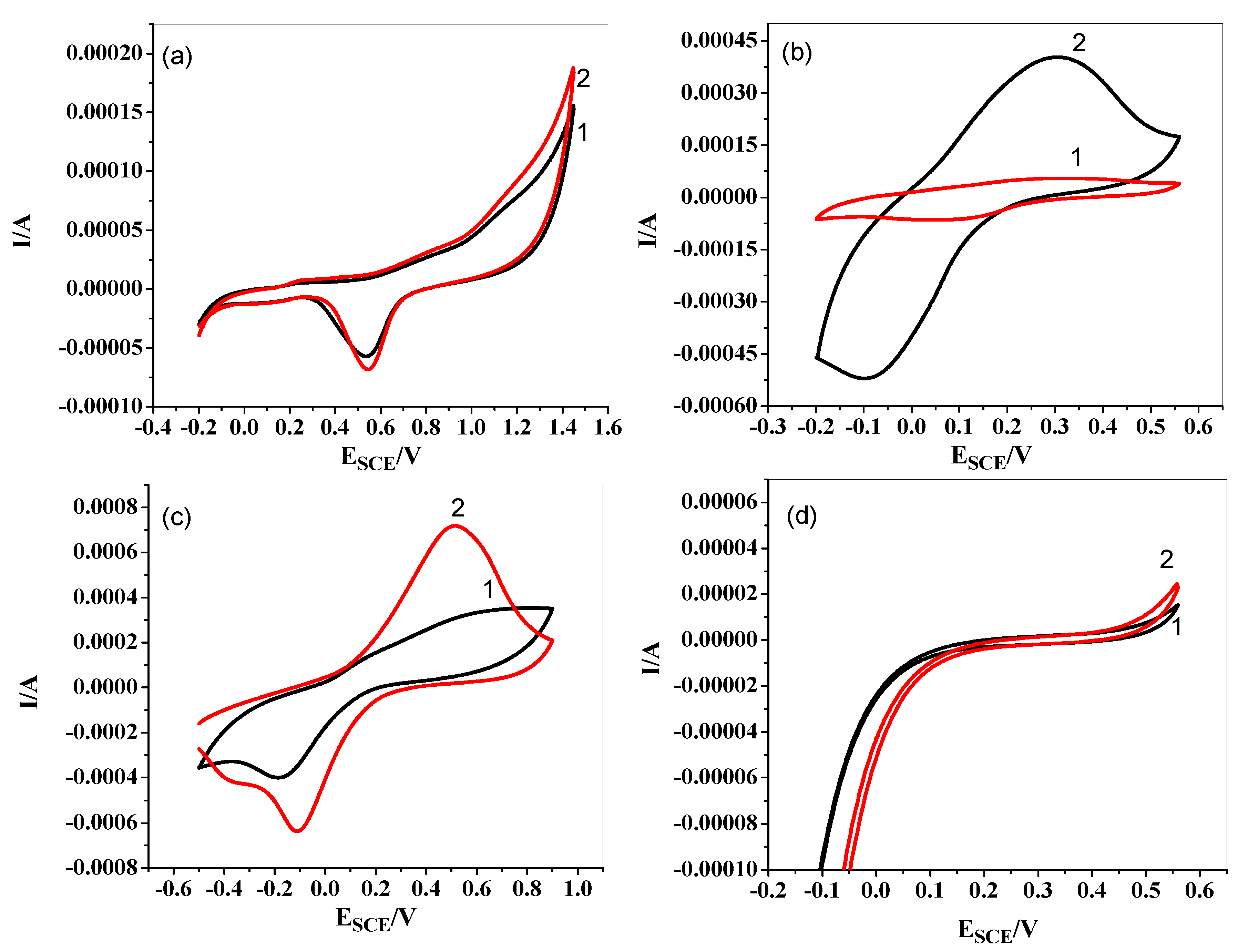
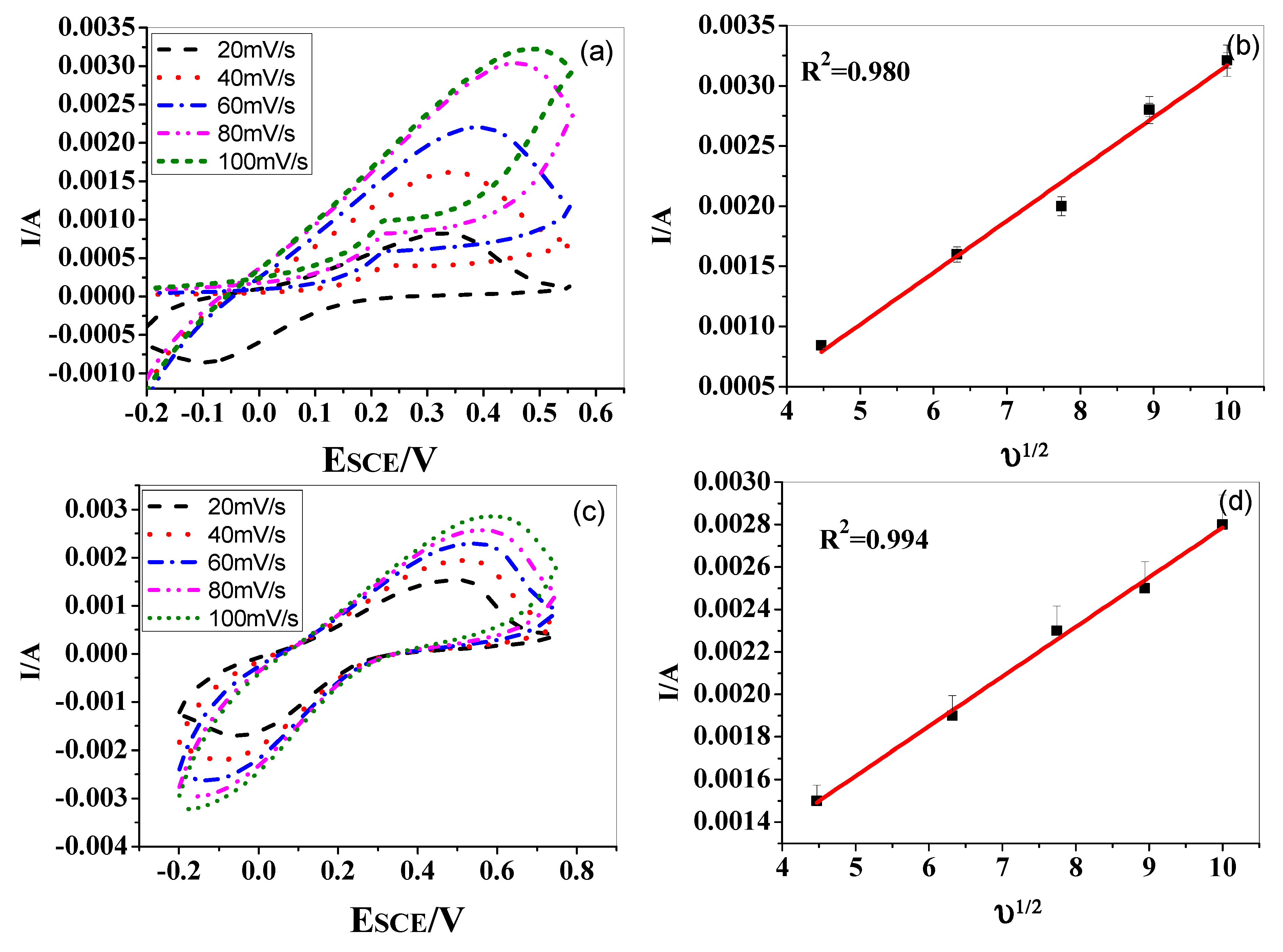
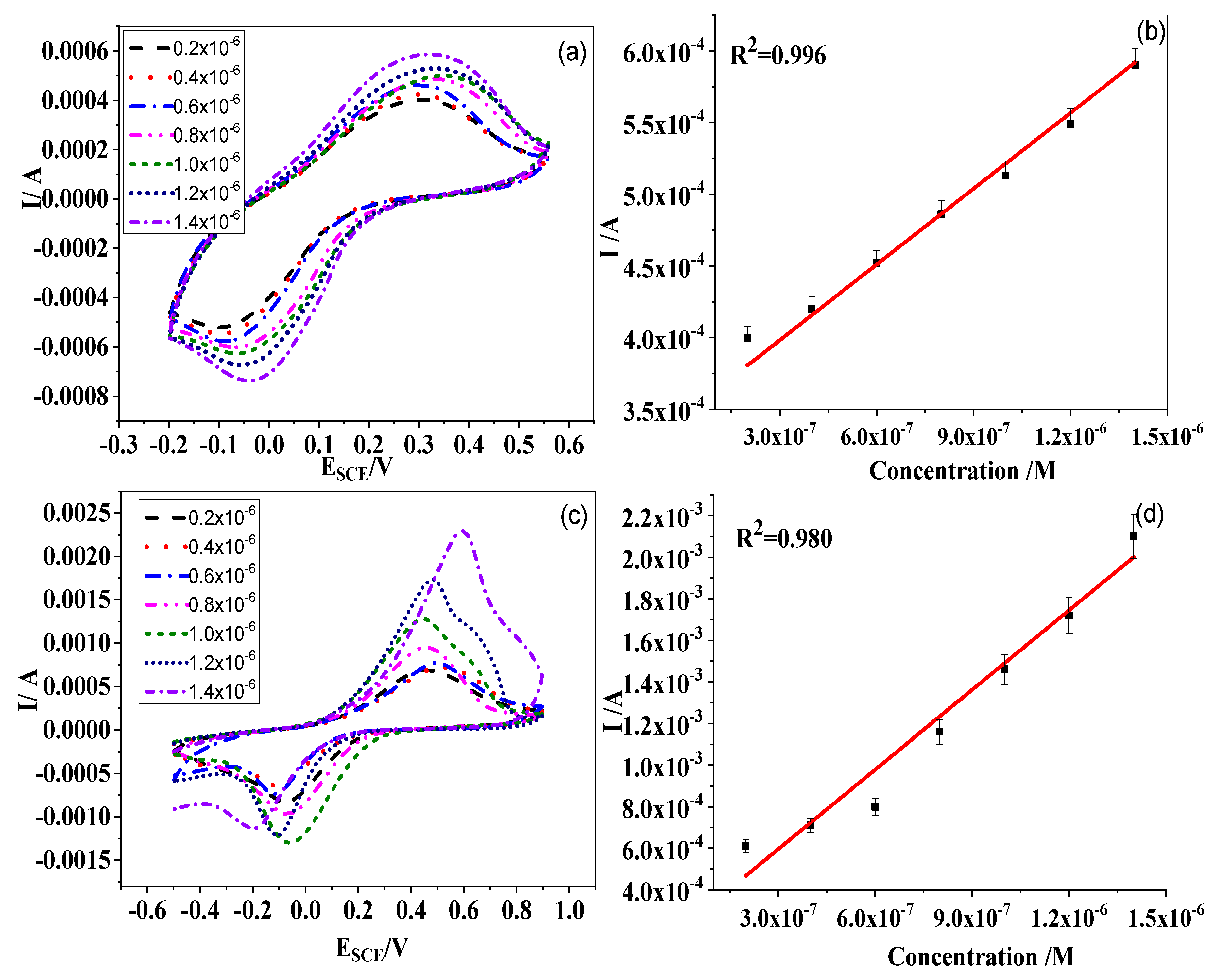
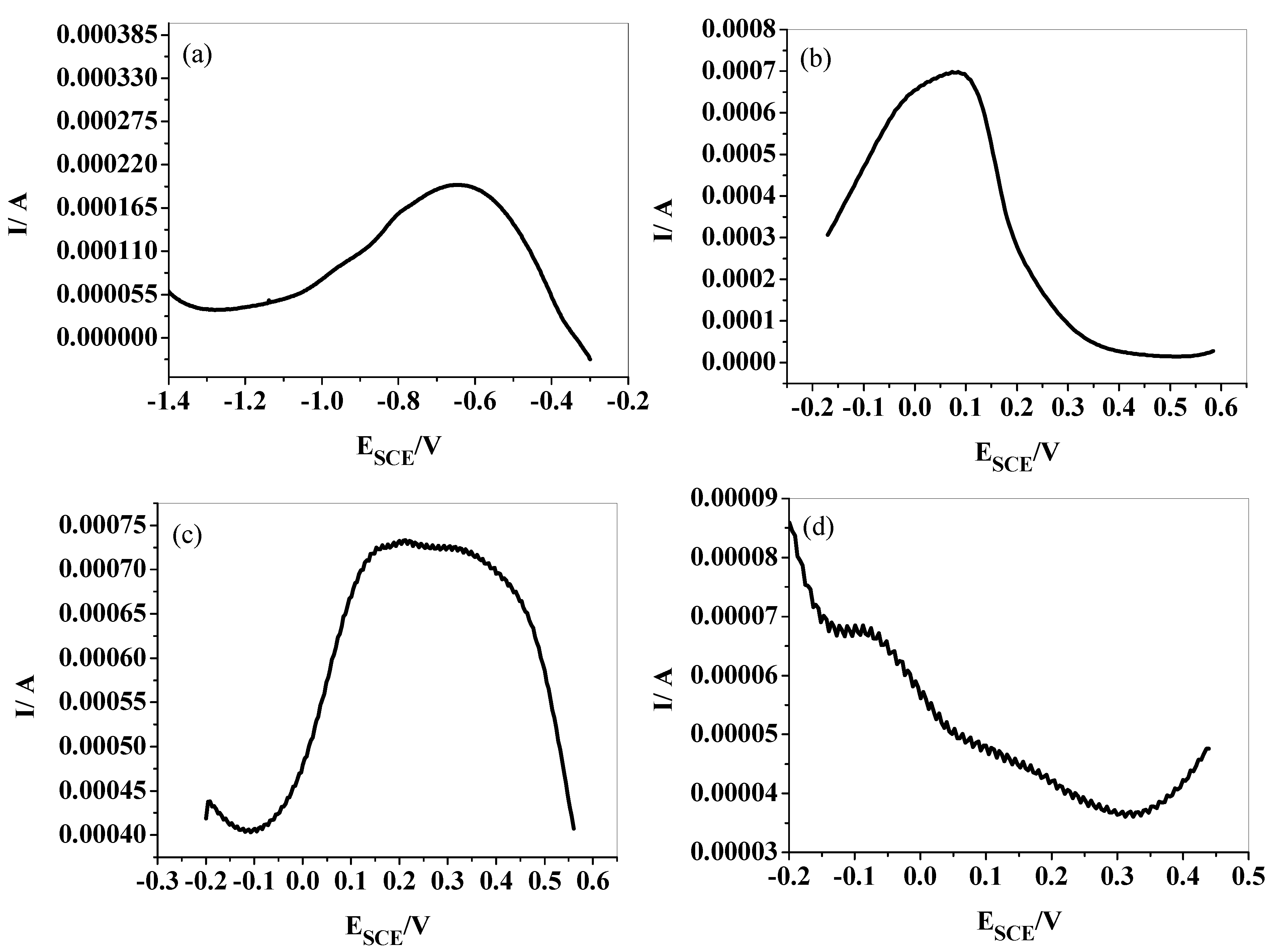
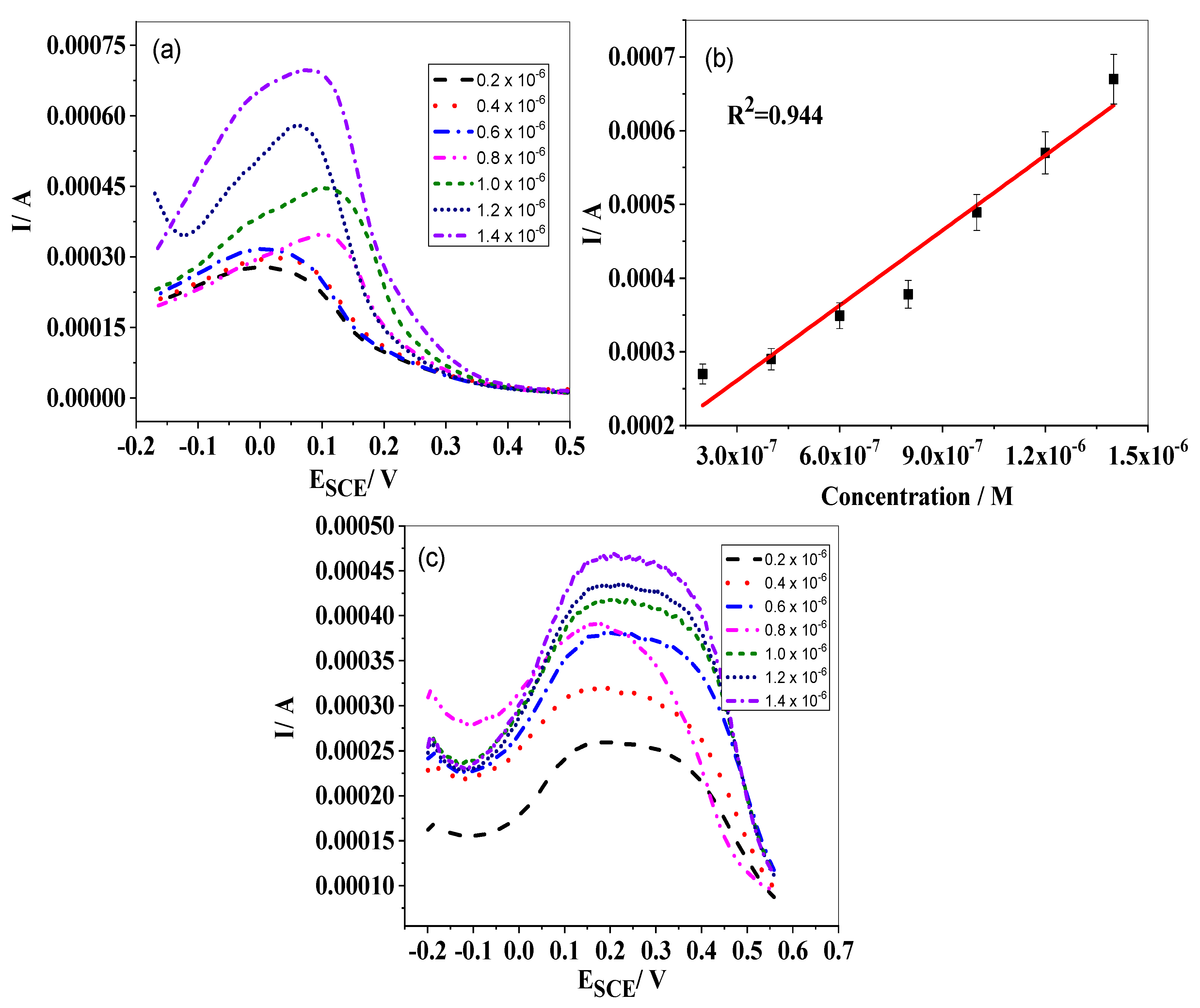
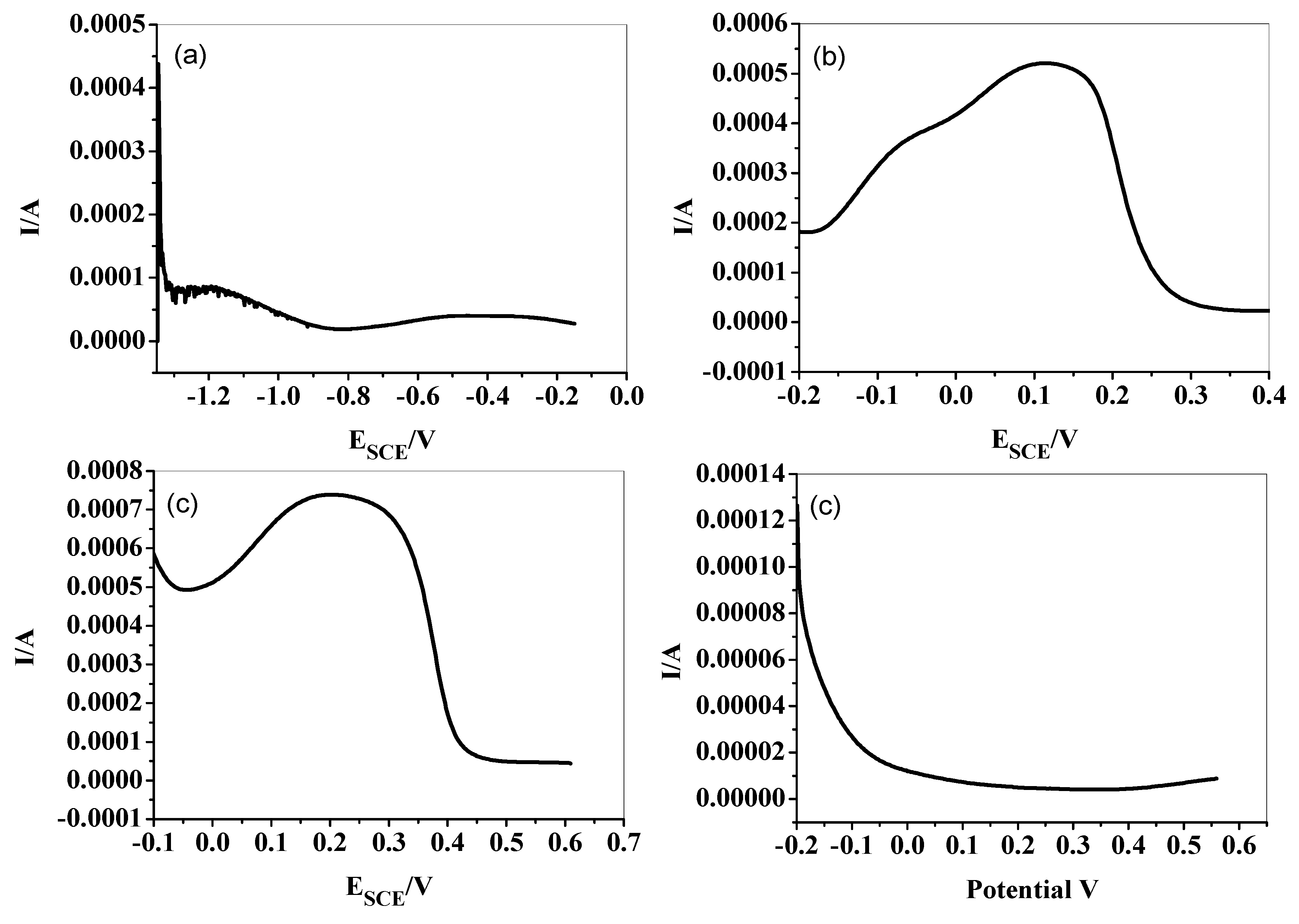
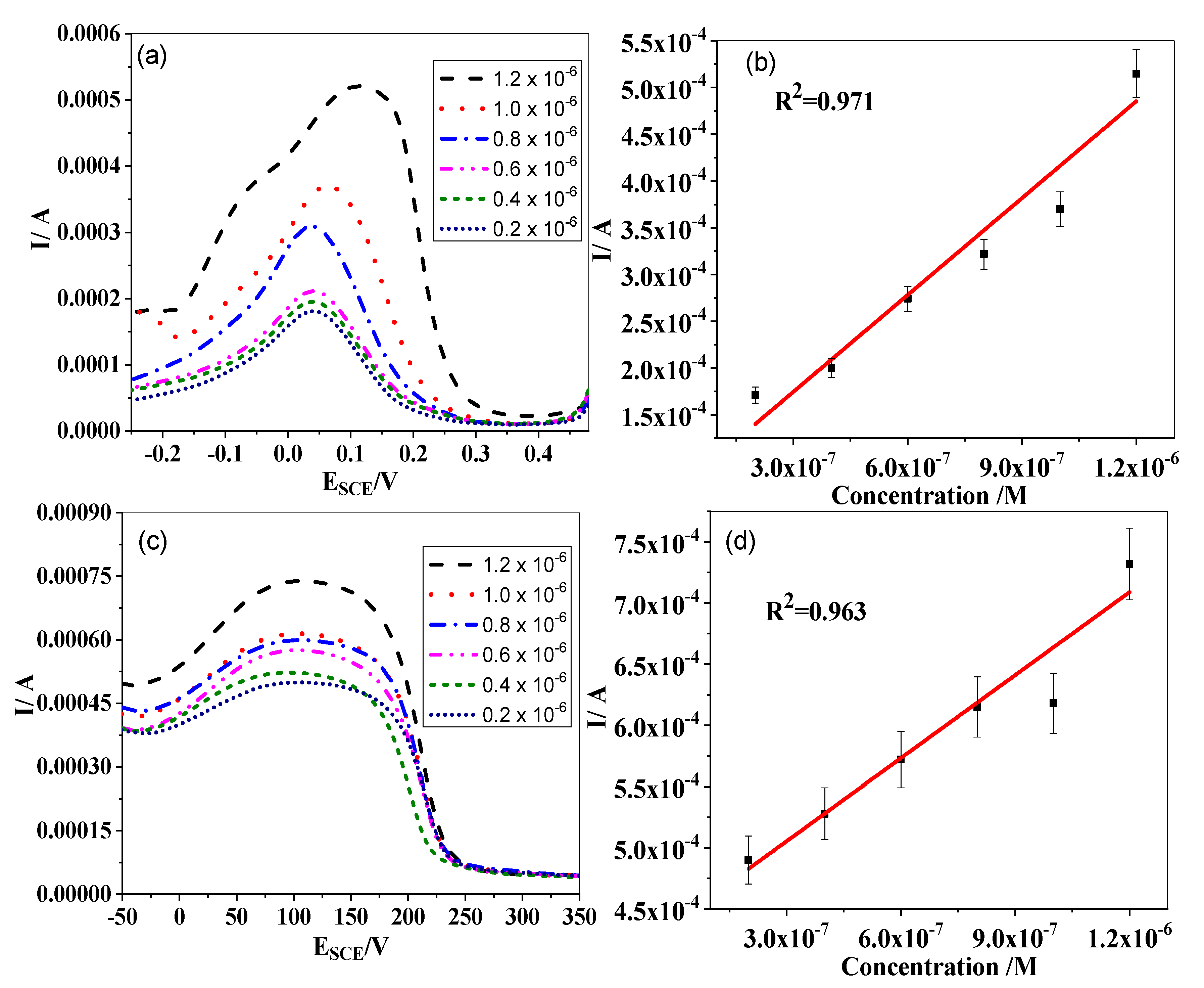
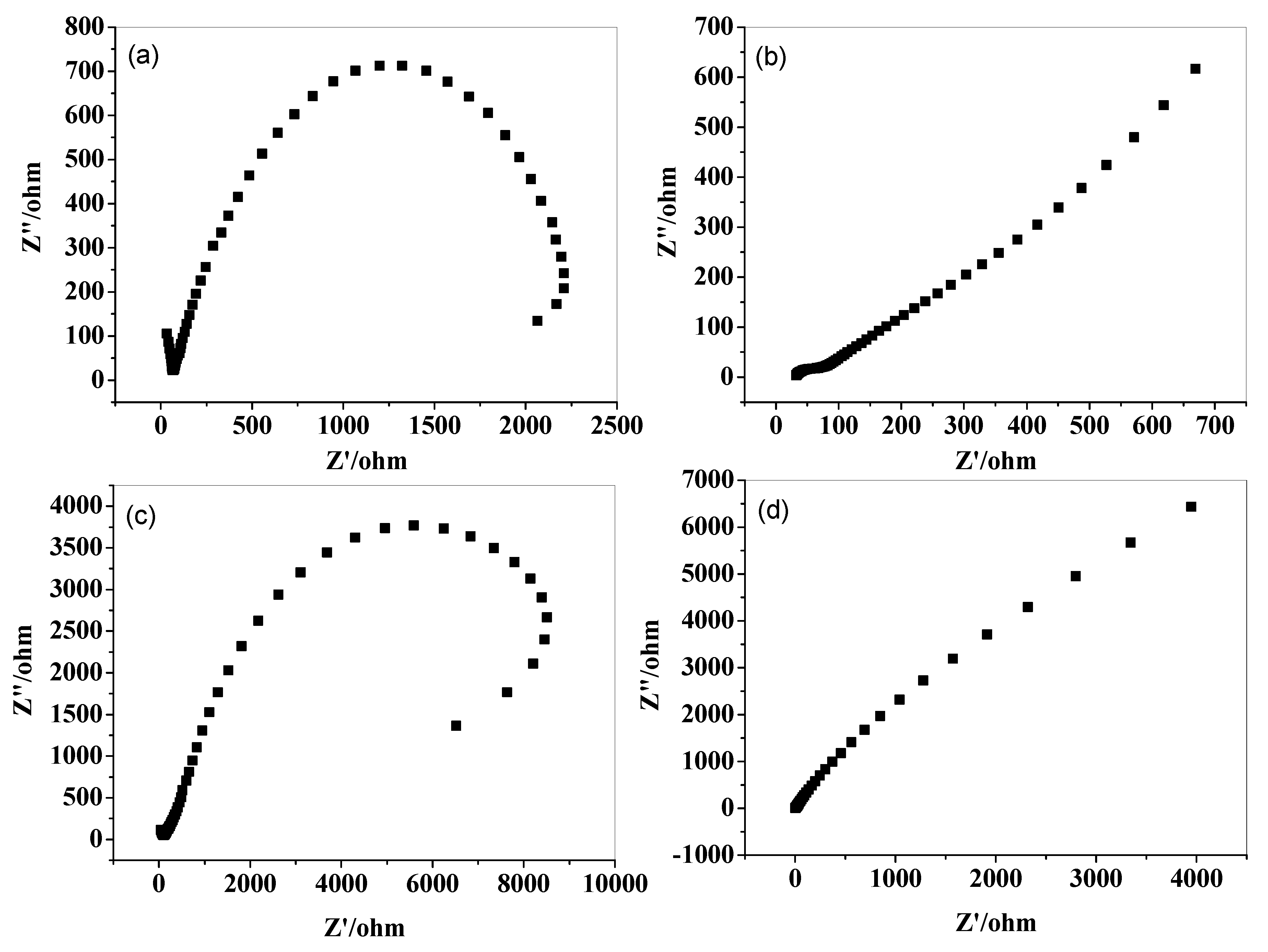
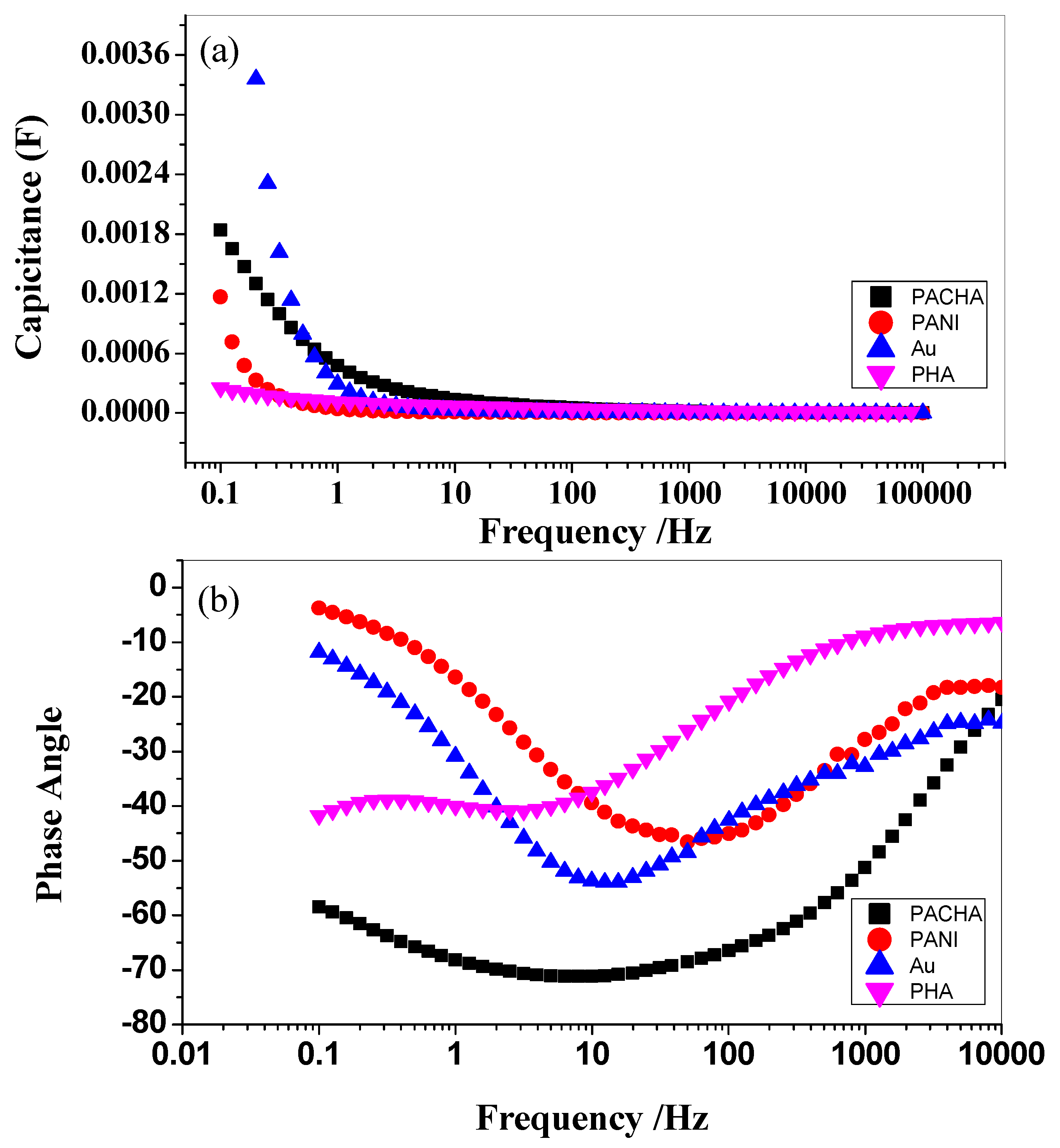
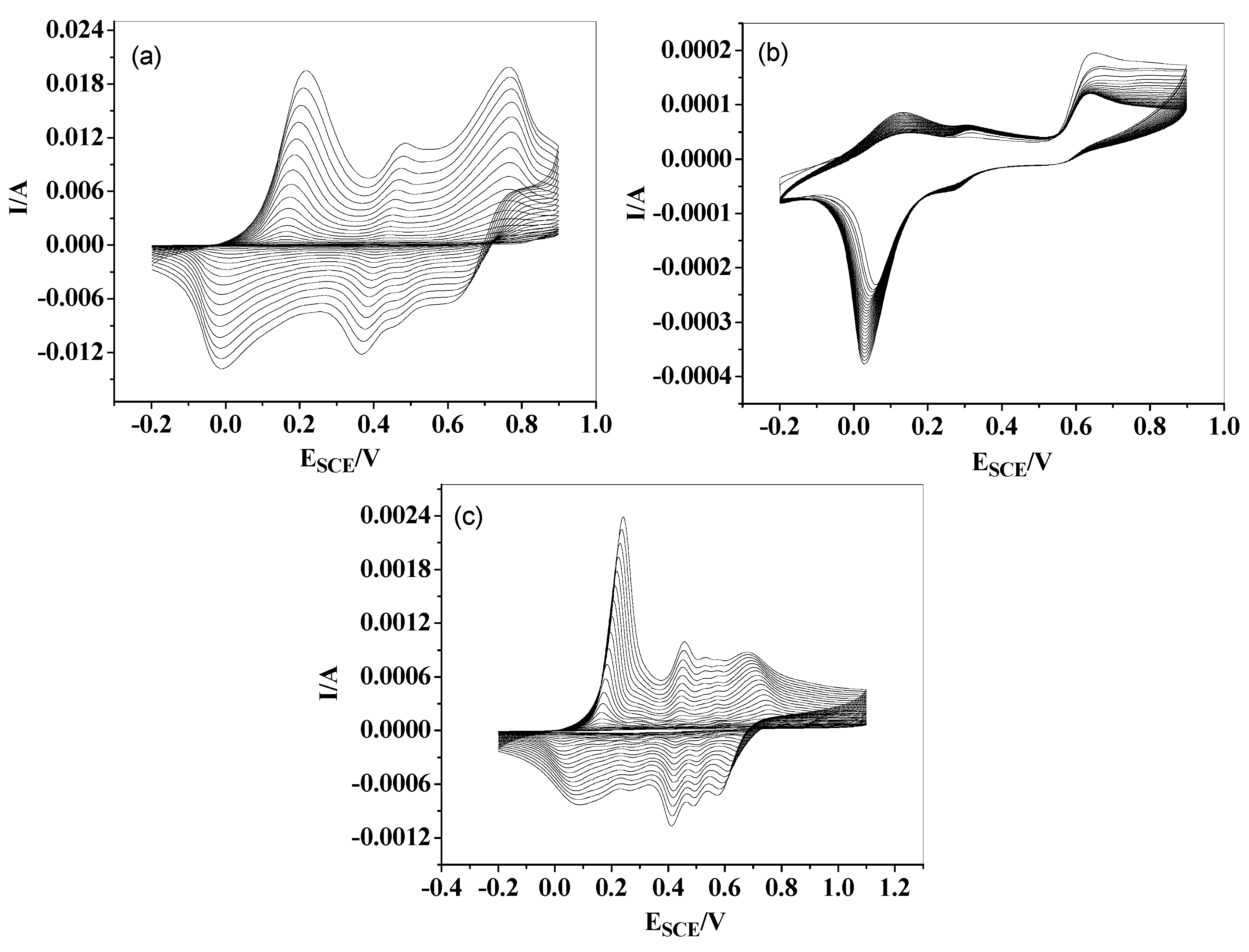
| Electrode Technique | Detection Potential | Linearity (M) | LOD (M) | LOQ (M) | Sensitivity A/Mcm2 |
|---|---|---|---|---|---|
| PACHA–Au, CV | 0.3 V | 2 × 10−7–1.4 × 10−6 | 1 × 10−7 | 3.3 × 10−7 | |
| PANI–Au, CV | 0.5 V | 2 × 10−7–1.4 × 10−6 | 1.15 × 10−7 | 3.8 × 10−7 | |
| PACHA–Au, SWV | 0.08 V | 2 × 10−7–1.4 × 10−6 | 1.78 × 10−7 | 5.6 × 10−7 | |
| PACHA–Au, DPV | 0.1 V | 2 × 10−7–1.4 × 10−6 | 1 × 10−7 | 3.3 × 10−7 | 650 |
| PANI–Au, DPV | 0.20 V | 2 × 10−7–1.4 × 10−6 | 1 × 10−7 | 3.3 × 10−7 | 434 |
| rGO-Nf@Ag6 | 5.35 × 10−7 [34] | ||||
| Silicon/silver nanocomposite | 1.65 × 10−6 –0.5 × 10−3 | 0.45 ×10−6 [35] | |||
| Au/graphene/HRP/CS | 1.7 × 10−6 [36] | ||||
| MWCNT–graphene | 20 × 10−6–2.1 × 10−3 | 9.4 × 10−6 [36] | |||
| BGNs | 1 × 10−3–20 × 10−3 | 3.8 × 10−6 [36] | 266.7 × 10−6 [36] | ||
| Ag NS/ITO | 0.2 × 10−3–4 × 10−3 | 1 × 10−6 [37] | |||
| Graphene–hAuPd | 0.1 × 10−6–20 × 10−6 | 5.059 [36] | |||
| RGO–MWCNT–Pt/Mb | 1.99 × 10−6 [36] |
© 2019 by the authors. Licensee MDPI, Basel, Switzerland. This article is an open access article distributed under the terms and conditions of the Creative Commons Attribution (CC BY) license (http://creativecommons.org/licenses/by/4.0/).
Share and Cite
Shah, A.u.H.A.; Inayat, A.; Bilal, S. Enhanced Electrocatalytic Behaviour of Poy(aniline-co-2-hydroxyaniline) Coated Electrodes for Hydrogen Peroxide Electrooxidation. Catalysts 2019, 9, 631. https://doi.org/10.3390/catal9080631
Shah AuHA, Inayat A, Bilal S. Enhanced Electrocatalytic Behaviour of Poy(aniline-co-2-hydroxyaniline) Coated Electrodes for Hydrogen Peroxide Electrooxidation. Catalysts. 2019; 9(8):631. https://doi.org/10.3390/catal9080631
Chicago/Turabian StyleShah, Anwar ul Haq Ali, Ayesha Inayat, and Salma Bilal. 2019. "Enhanced Electrocatalytic Behaviour of Poy(aniline-co-2-hydroxyaniline) Coated Electrodes for Hydrogen Peroxide Electrooxidation" Catalysts 9, no. 8: 631. https://doi.org/10.3390/catal9080631
APA StyleShah, A. u. H. A., Inayat, A., & Bilal, S. (2019). Enhanced Electrocatalytic Behaviour of Poy(aniline-co-2-hydroxyaniline) Coated Electrodes for Hydrogen Peroxide Electrooxidation. Catalysts, 9(8), 631. https://doi.org/10.3390/catal9080631







